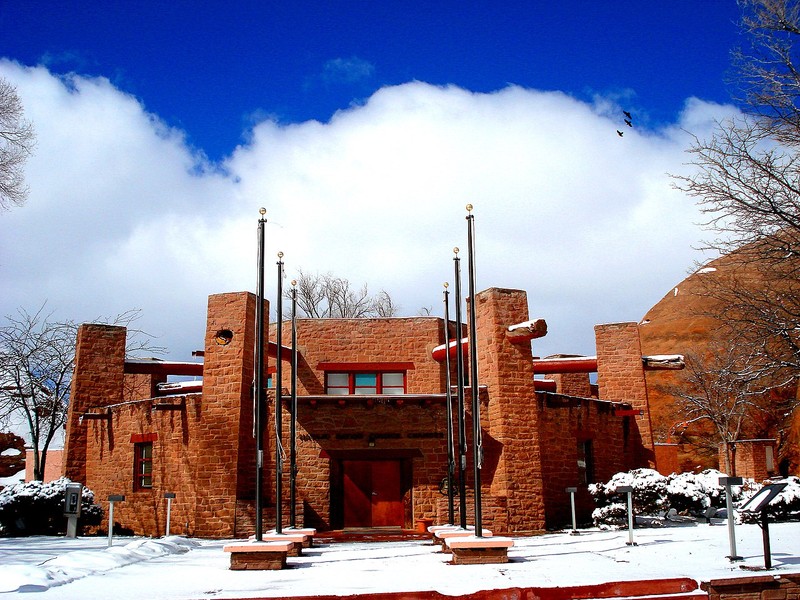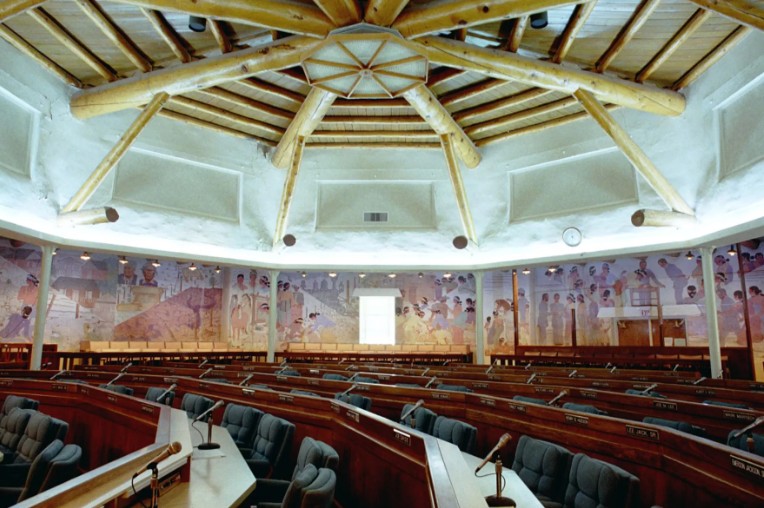Navajo Nation Council Chamber
Introduction
Text-to-speech Audio
Designated a National Historic Landmark in 2004, the Navajo Nation Council Chamber was built in 1935 and is the home of the Navajo tribal government. It is the only legislative building in the country continuously occupied by a Native American tribe and designed using native materials and architectural traditions. Resembling a traditional Navajo building called a hogan, it is octagonal in shape (the second level is five-sided), the main entrance faces east, and the north wall is windowless. The Chamber is the centerpiece of a complex of Navajo governmental buildings also erected in the mid-1930s. Its construction represents the beginning of an era of self governance for the Navajo following the passage of the Indian Reorganization Act in 1934, which completely reshaped federal Indian policy.
Images
The Navajo Nation Council Chamber was built in 1935 and is the only legislative building in the country continuously occupied by a Native American tribe.

Interior view of the Council Chamber.

Backstory and Context
Text-to-speech Audio
Before the Indian Reorganization Act, federal policy towards Native Americans was one of assimilating them into American society by suppressing native language, culture and religion. Central to this effort was allotting parts of reservation land to individual Indian males and forcing Indian children to live and be educated at government-run boarding schools. The ultimate goal was to transform indigenous people into American citizens. However, these policies were incredibly destructive to Native Americans. They severely damaged Native heritage and identity by placing Native Americans in between tradition and white American culture. In general, there was little economic activity or job opportunities on reservations, especially during the Great Depression, and many Natives suffered from disease and poverty. Drought and another federal policy, the culling of livestock to reduce overgrazing (the government believed livestock was contributing to drought conditions), were detrimental to the Navajo and other tribes in the Southwest.
The person largely responsible for transforming federal Indian policy was John Collier, who became the Indian Affairs Commissioner in 1933. A graduate of Columbia University and the College de France, where he studied psychology, Collier served as the director of California's adult education program in the 1920s. He came to admire Indian culture after witnessing Pueblo Indian ceremonies in Taos, New Mexico. In 1922, he became the secretary of a lobbying organization called the Indian Defense Association and wrote an article criticizing federal Indian policies.
In his role as Indian Affairs Commissioner (he reported to the Secretary of the Interior, Harold Ickes), Collier developed a plan called the Indian New Deal. It called for the ending of the allotment policy, promoted economic development, terminating forced assimilation, replacing boarding schools with day schools, and either strengthening tribal government. Not all Native Americans supported these changes as some had assimilated into American society and did not want to revive native culture. Natives who held this view were "modernists"; those who wanted to retain native culture were considered "traditionalists."
The Navajo and other Arizona tribes were traditionalists and Collier believed the Navajo tribe could be a testing ground for his ideas. The Treaty of 1868, which created the Navajo Nation reservation, established a formal political relationship between the federal and the tribe, although the Navajos did not have political structure in place. That didn't come until 1901 when the government created six districts in the reservation. However, it wasn't until the oil was found in 1923 that the legislative body of the Navajo government, the Navajo Nation Council (formerly known as the Tribal Council) was established. Given the Navajo's adherence to tradition and their nascent political system, Collier considered then ideally suited to apply his ideas.
To develop the reservation, Collier requested funds from the Public Works Administration (PWA), which was one of several "New Deal" federal agencies created during the Great Depression to provide jobs to Americans out of work. The funds were sent to an agency called the Indian Emergency Conservation Work, which was part of the Civilian Conservation Corps. On reservations across the country, native workers built roads, fences, phone lines, dug wells and completed other projects.
In Arizona, PWA money funded the construction of schools, dams, irrigation canals, and roads. It also funded the construction of the Council Chamber and other government buildings. Designed by the New York City-based firm Mayers Murray & Phillip, it is 70-feet wide and features stone tiers with exposed Ponderosa pine beams that support the roof. Inside, the Chamber features a mural called "The History and Progress of the Navajo Nation" painted by Gerald Nailor. The building has been slightly altered over the years to meet the needs of the Council but has not lost its original integrity. The Navajo assumed ownership of the Chamber in 1960 (until then it belonged to the Bureau of Indian Affairs).
Sources
Burt, Sarah. "Navajo Nation Council Chamber." National Park Service - National Historic Landmark Nomination Form. August 18, 2004. https://npgallery.nps.gov/GetAsset/5efd0042-3308-4ac2-b020-58c8d6f1dfb7.
"Navajo History." Discover Navajo. Accessed October 21, 2023. https://discovernavajo.com/navajo-history.
Wikimedia Commons
Discover Navajo
